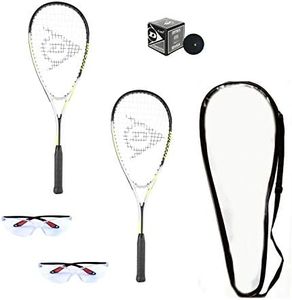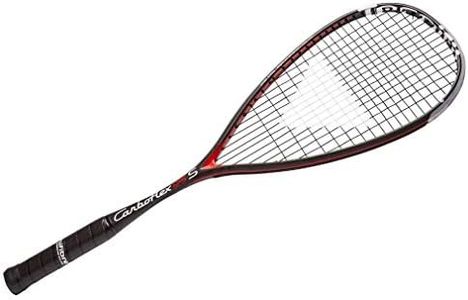We Use CookiesWe use cookies to enhance the security, performance,
functionality and for analytical and promotional activities. By continuing to browse this site you
are agreeing to our privacy policy
10 Best Squash Racquets
From leading brands and best sellers available on the web.Buying Guide for the Best Squash Racquets
Choosing the right squash racquet can make a huge difference in your game, whether you are a beginner, intermediate, or advanced player. The racquet is more than just equipment—it's an extension of your arm and can affect your power, control, and overall comfort on the court. Understanding the key specifications and how they relate to your personal playing style and physical characteristics is essential to finding the best match for you.WeightThe weight of a squash racquet is an important factor because it affects how easy the racquet is to swing and how much power or control you can generate. Racquets usually range from very light (around 110 grams) to somewhat heavier (near 170 grams). Lighter racquets allow for quick movement and fast wrist action, making them perfect for players who rely on speed and agility. Heavier racquets can provide more power but may tire your arm faster and are better suited for players who prefer a slower, controlled game, or who have a strong arm. When deciding what's best for you, consider your own strength, playing style, and how long you play each session: fast, attacking players often like lighter racquets, while those who value control might choose a heavier model.
BalanceBalance describes where the majority of the racquet’s weight is located—toward the head, the handle, or evenly distributed. Head-light racquets are easier to maneuver and great for quick reaction shots, while head-heavy racquets help generate more powerful hits as the weight gives extra momentum. Even-balance racquets offer a middle ground, balancing both power and control. To decide, think about whether you need extra speed for volleying and rapid movements (choose head-light), more help with deep, powerful shots (pick head-heavy), or want something versatile (even-balance).
String PatternThe string pattern refers to how tightly the strings are arranged across the racquet face. There are ‘open’ patterns (fewer strings), which can give you more power and spin but tend to wear out faster, and ‘dense’ patterns (more strings), offering better control and durability. If you’re a player who likes to put spin on your shots or wants more bounce, go for a more open pattern, but if you want your strings to last or to maximize control, a denser pattern is better.
Grip SizeGrip size is the thickness of the handle and is important for comfort and control. Too thick or thin a grip can tire your hand or make mishits more likely. Most squash racquets come with a standard grip size, which fits most hands, but you can adjust with overgrips. If you have smaller hands or like to flick your wrist, a thinner grip may suit you; for larger hands or extra stability, you may prefer a thicker grip. Always try holding the racquet in your hand to see what feels right.
Frame MaterialThe material of the racquet frame affects weight, flexibility, and durability. Most modern racquets are made from graphite or a mix of graphite with other lightweight materials. Graphite racquets are strong and provide a good balance of power and control, while racquets with added materials (such as titanium or carbon) may be lighter or more durable. If you want a racquet that’s easy to handle and lasts a long time, look for those made of advanced composite materials.
Head Shape/SizeThe head shape determines the size and position of the racquet’s sweet spot (the best area to hit the ball). Teardrop-shaped heads generally offer a larger sweet spot and more power, while traditional oval heads provide more control. If you often hit off-center shots or are looking for more power, choose a larger, teardrop-shaped head; if your shots are already accurate, you might prioritize control with a more classic shape.















